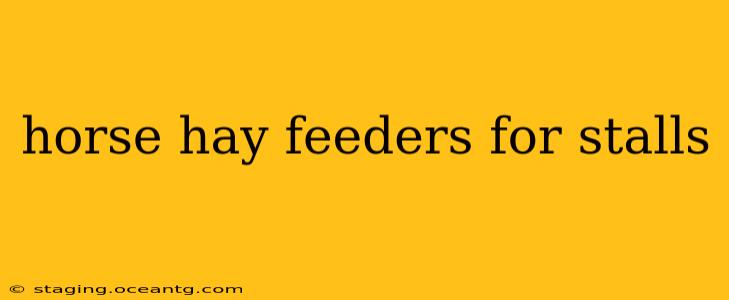Choosing the right hay feeder for your horse's stall is crucial for their health, comfort, and the cleanliness of their environment. This guide explores various types of horse hay feeders, helping you select the best option to meet your horse's needs and your stable's setup. We'll also address common questions horse owners have about these essential pieces of equine equipment.
What are the Different Types of Horse Hay Feeders for Stalls?
Several types of hay feeders cater to different horse breeds, sizes, feeding styles, and stable designs. The most common include:
-
Slow Feed Hay Nets: These are excellent for preventing horses from gorging themselves, especially beneficial for horses prone to colic or weight gain. They come in various sizes and mesh densities, allowing you to control the hay release rate. Some are designed to hang from the ceiling, while others are designed to sit on the ground.
-
Hay Bags: Similar to slow feed nets, hay bags often have larger openings, allowing for slightly faster hay consumption. They are a good option for horses who aren't excessively fast eaters.
-
Hanging Hay Feeders: These feeders suspend hay above the ground, preventing spillage and waste. They are generally made of metal wire or heavy-duty plastic and often have a wide opening to accommodate large hay bales.
-
Floor Hay Feeders: These feeders sit on the floor and are designed to contain hay, reducing waste and preventing your horse from trampling their food. They are available in various materials, including metal, plastic, and even wood. Some are designed to be slow feeders, while others offer faster access to hay.
-
Automatic Hay Feeders: These advanced feeders dispense hay at programmed intervals, offering a high degree of control over your horse's feeding schedule. They are ideal for horses requiring precise feeding management or for busy owners. Note that these tend to be more expensive.
What Size Hay Feeder Should I Choose for My Horse?
The ideal size depends on your horse's breed, size, and eating habits. A larger horse will naturally need a larger feeder to accommodate their hay intake. Consider the amount of hay your horse consumes daily and select a feeder that can comfortably hold that quantity for a feeding period. Remember to prioritize safety. A feeder that is too small may encourage your horse to overeat or become frustrated.
How Do I Prevent My Horse from Destroying Their Hay Feeder?
Some horses are more destructive than others. To prevent damage:
- Choose durable materials: Opt for heavy-duty metal or reinforced plastic feeders known for their resilience.
- Secure the feeder properly: If using a hanging feeder, ensure it's firmly attached to a strong and stable structure. For floor feeders, make sure they are heavy enough not to be easily tipped over.
- Supervise your horse: Especially when introducing a new feeder, monitor your horse's interaction to identify and address any destructive behavior early on.
What are the Benefits of Using a Hay Feeder?
Hay feeders offer numerous benefits:
- Reduced Hay Waste: Preventing your horse from trampling or wasting hay saves you money.
- Improved Hygiene: Containing hay reduces the spread of manure and urine in the stall, creating a cleaner environment.
- Controlled Feeding: Slow-feed feeders promote healthy digestion and reduce the risk of colic.
- Reduced Stress: Providing a dedicated feeding space reduces competition and allows for more relaxed eating.
Are there different materials to choose from?
Yes, hay feeders are available in various materials, each with its pros and cons:
- Metal: Durable and long-lasting, but can rust if not properly maintained.
- Plastic: Lightweight and easy to clean, but can be less durable than metal.
- Wood: Can be aesthetically pleasing, but requires more maintenance and may be less durable than metal or plastic.
Ultimately, the best material depends on your budget, your horse's behavior, and your preference.
This guide provides a comprehensive overview of horse hay feeders for stalls. By considering your horse's individual needs and carefully selecting a feeder, you can create a safer, more comfortable, and healthier environment for your equine companion. Remember to always prioritize your horse's well-being when making your decision.
